Dataset Market
We have introduced the Dataset Market on the basis of application creation. The Dataset Market adopts a multi-level storage method, establishing appropriate data cubes to meet the needs of specific departments, users, or user groups, including analysis, content, and usability.
Administrators can create folders and data packages in the Dataset Market, and set permissions for folders and data packages. By setting permissions for folders and data packages, authorized users can legally view and use the data in the authorized folders and data packages.
Folder
Only users with the System Administrator role can create folders in the Data Mart. Folders can still contain subfolders and new data packages.
When creating a folder, if the folder is empty, a prompt will appear: "Please fill in the folder name."
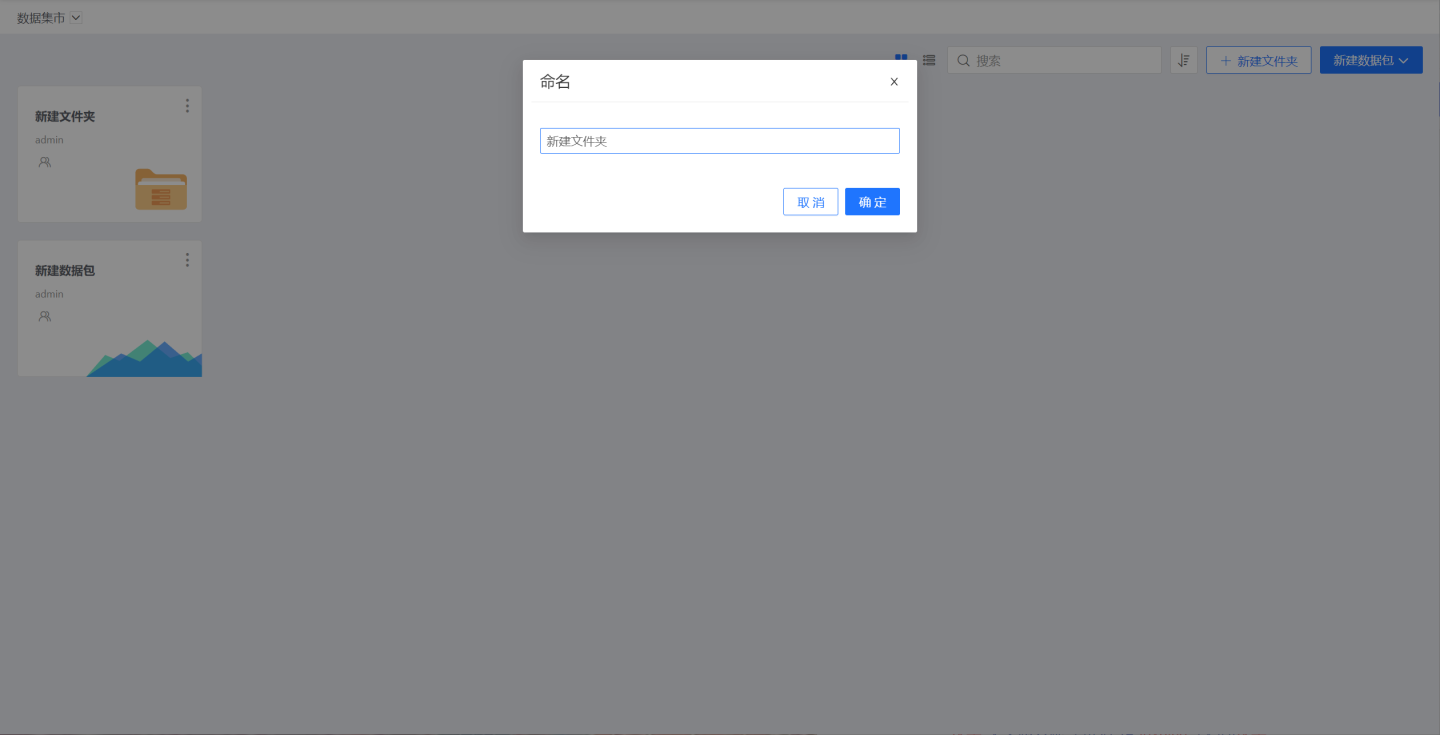
Operations that can be performed on a folder include:
- Permission Management
- Move
- Rename
- Delete
Permission Management
Users with the Manager permission for a folder have the authority to grant Manager, Editor, or Viewer permissions to users, user groups, or organizational structures.
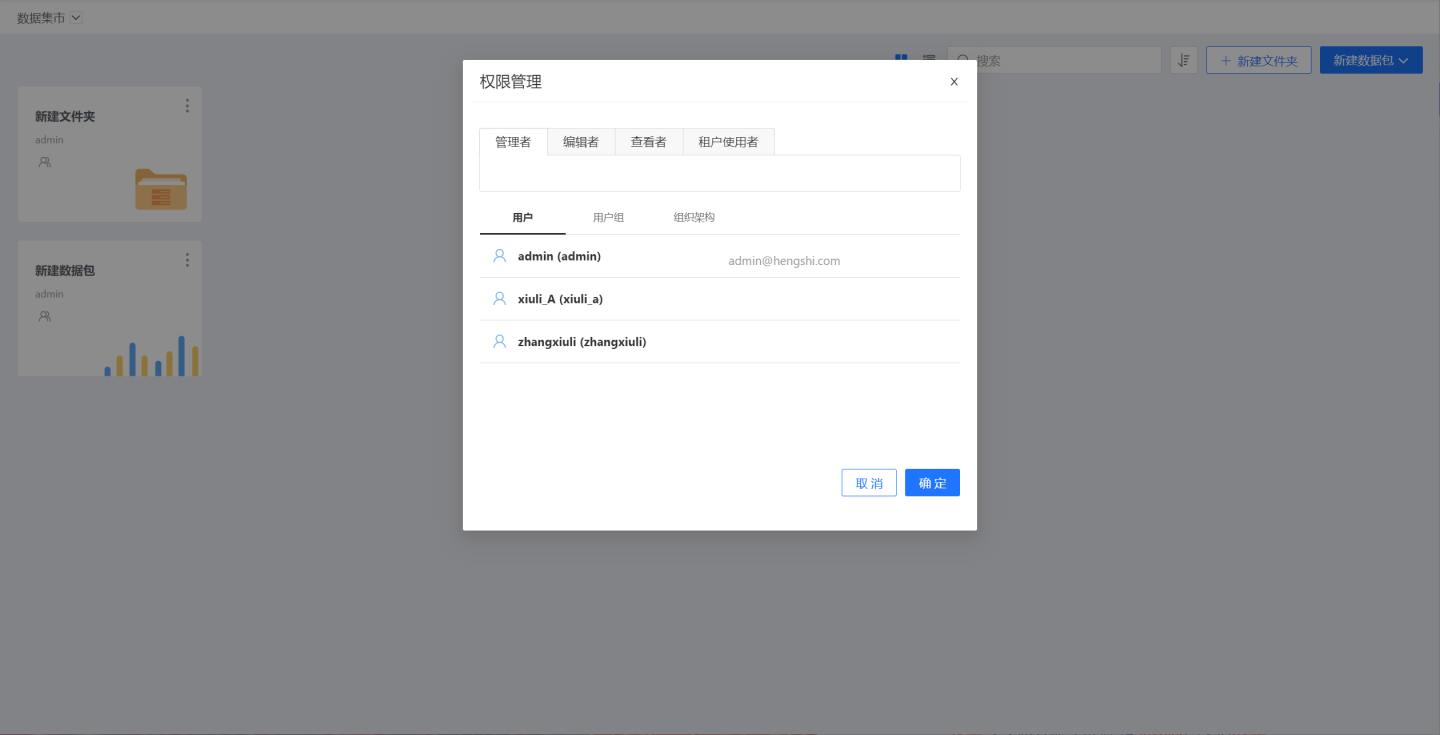
When analysts enter the Data Mart, if they have the Manager permission for a folder, they can perform the following operations on the folder:
Permission Management
Rename
Move
Delete
When analysts enter the Data Mart, if they only have the Editor permission for a folder, they can perform the following operations on the folder:
- Rename
- Move
- Delete
When analysts enter the Data Mart, if they only have the Viewer permission for a folder, they cannot perform any operations on the folder.
Rename
In the folder's menu, there is an operation button for renaming. If a folder with the same name already exists in the current path of the dataset market, a prompt will appear: "The folder name already exists, please choose another name."
Move
In the folder's menu, there is an operation button for moving, which allows you to move the folder to another folder where you have editing permissions.
When moving, you can choose to retain the permission settings. If the mover does not have administrator permissions for the target folder, they will not be able to retain the permission settings.
Delete
There is an operation button for deletion in the folder's menu. If the folder is empty, it prompts "Deletion successful"; if the folder is not empty, it prompts "Folder is not empty".
Dataset
Create Data Package
Users with both the System Administration and Data Management roles can create new data packages in the data mart. If a user only has the Data Management role, they can create data packages in folders where they are authorized as Manager or Editor.
Creating a data package is divided into two types:
- Blank Data Package
The default name for the data package is "New Data Package," which can be modified to a name that is more aligned with business logic.
Users can create datasets, process data, establish relational models, create charts and tables within the data package to meet specific analysis needs.
- Import Template
Select a previously exported JSON file for upload to successfully import.
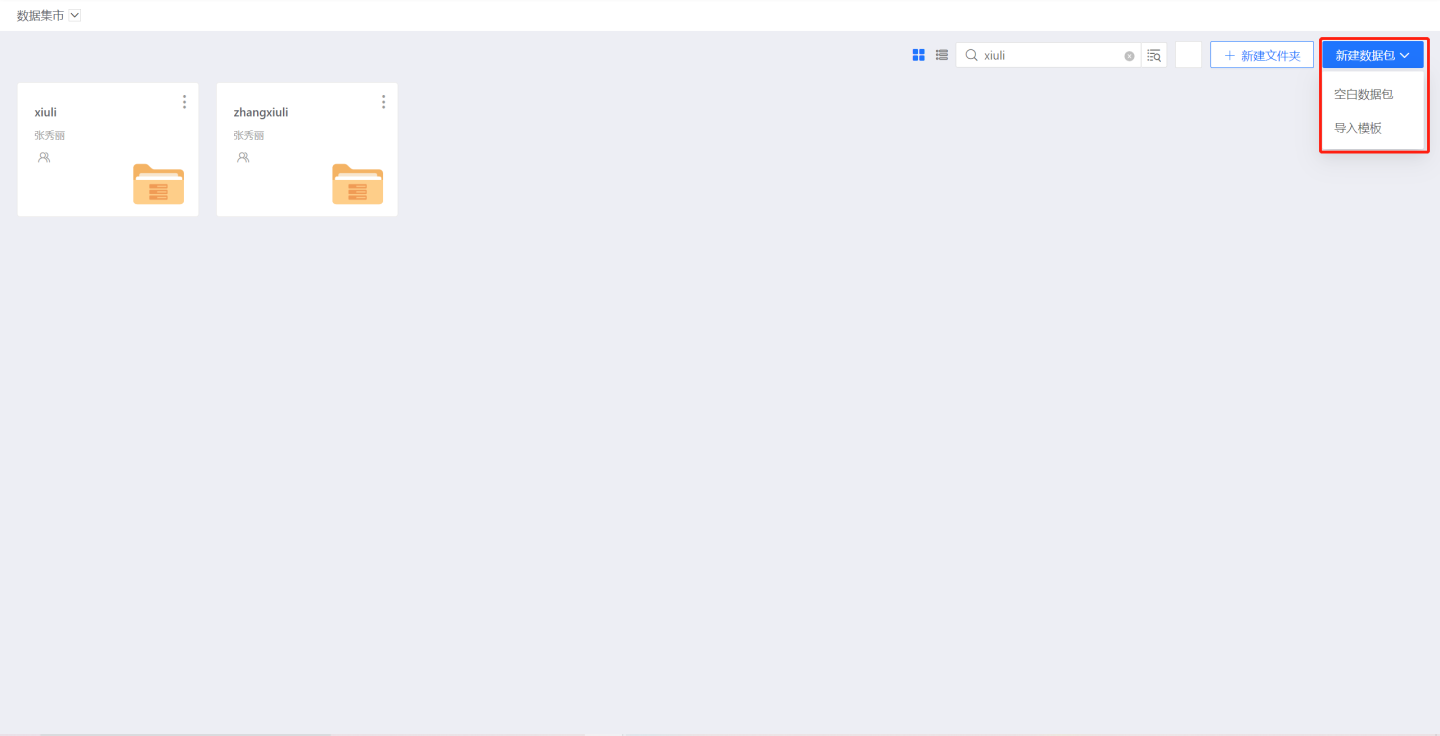
Operations that can be performed on the data package include:
- Permission Management
- Export Template
- Import and Replace
- Create Copy
- Copy To
- Replace Data Connection
- Rename
- Move
- Delete
Permission Management
Users with the Manager permission for a data package have the authority to grant Manager, Editor, or Viewer permissions to users, user groups, or organizational structures.
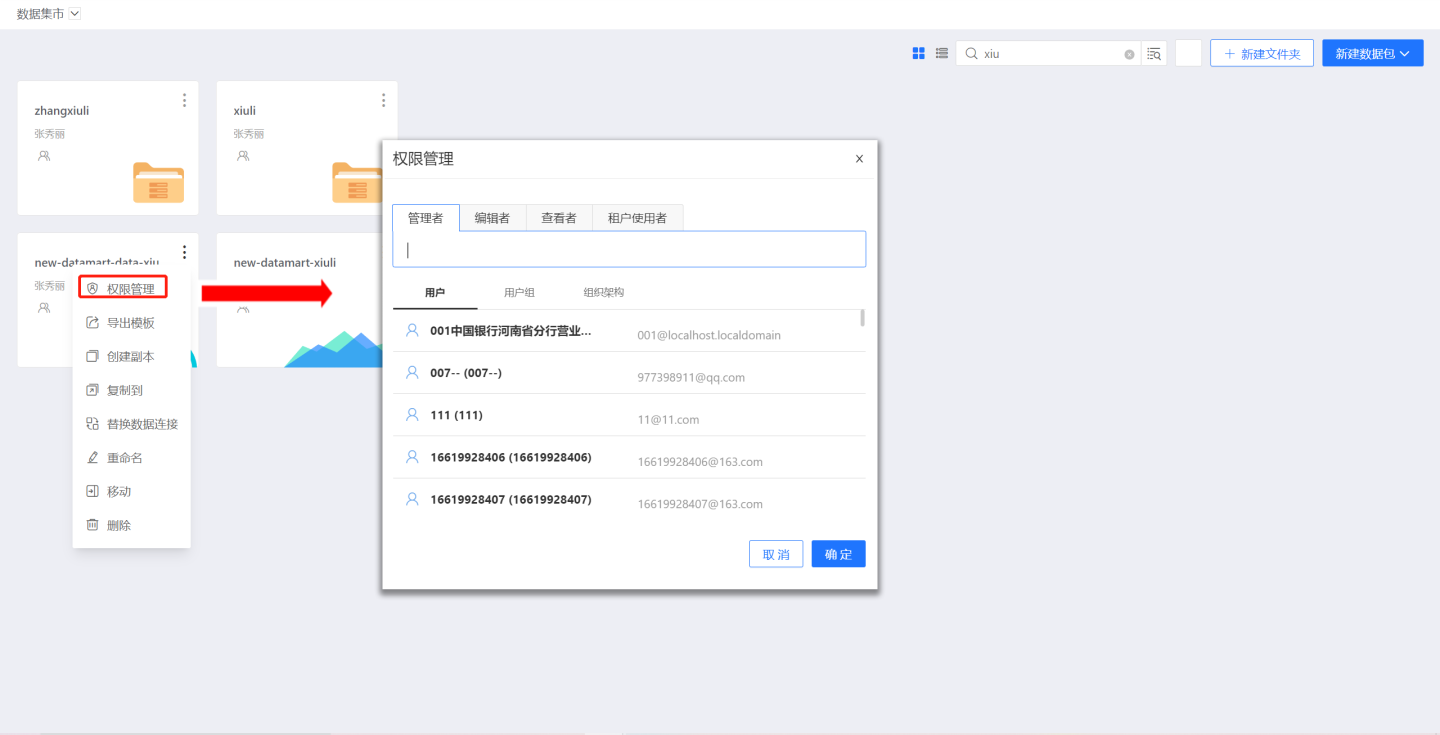
When analysts enter the Data Mart, if they have the Manager permission for a data package, they can perform the following operations on the data package:
- Permission Management
- Export Template
- Import and Replace
- Create Copy
- Copy To
- Replace Data Connection
- Rename
- Move
- Delete
When analysts enter the Data Mart, if they have the Editor permission for a data package, they can perform the following operations on the data package:
- Export Template
- Create Copy
- Copy To
- Replace Data Connection
- Rename
- Move
- Delete
When analysts enter the Data Mart, if they only have the Viewer permission for a data package, they can perform the following operations on the data package:
- Export Template
Export Template
Export Template refers to exporting the datasets, chart library, data models, and other contents in the current data package into a json format file. Users can quickly create a new data package using the template.
Import Template
Create Data Package Import Template
Click New Data Package -> Import Template, open the data package template in the pop-up file dialog, and the template import is completed, creating a new data package.
The new data package contains the datasets and data models of the template data package, on which users can perform data exploration.
- Data Package Name for Imported Template: The name of the data package imported from the template is the same as the template name. If there is a data package with the same name in the directory, the naming method for the data package after importing the template is: "Template Name" + "(1)". Users can also customize the data package name.
- Application Data for Imported Template: The data package imported from the template requires users to reconfirm the data.
- If the datasets in the template are local files, these datasets will be empty and contain no data, and data can only be added by replacing the datasets.
- If the datasets are direct-connected datasets or SQL query datasets, the corresponding data will be displayed based on the current user's permissions for the data connections corresponding to the datasets.
- The relationships established between datasets in the data model will be retained. The association models established using local files will have their relationships saved, and data can be re-added for use. The association models established between direct-connected datasets and SQL query datasets will have both their relationships and data preserved.
- Permission Configuration for Imported Template: When the template includes permission configuration, the relevant permission configuration content in the template can be imported. This is an optional operation and will only take effect if selected.
- When importing permissions, if the user objects cannot be matched in the system, the authorization rules will be retained during import, and the authorization objects will be discarded.
Import Template with Existing Data Package
Existing data packages also support importing templates. By selecting the template with Import and Replace, the template content will replace the datasets, chart library, and other content in the current data package.
Create a Copy
The dataset menu has the Create Copy button. Clicking Create Copy will generate an app with the same data as this dataset.
Creating a copy only generates a new dataset under the current path, with the name appended with (1) after the original dataset name.
Copy to
The data package menu includes a Copy to button. Clicking Copy to will display a copy dialog. In the dialog, select the path where the data package should be copied, and after confirming, the data package will be copied to the corresponding path.
Copy to allows modifying the data package name and selecting the copy path.

Replace Data Connection
The data package menu has the Replace Data Connection button. Clicking Replace Data Connection allows you to select the data connection you want to replace.
Rename
The menu of the data package has an operation button for renaming. If a data package with the same name already exists under the current path of the dataset market, a prompt will appear: "The application name already exists, please choose another name."
Move
In the dataset's menu, there is an action button called "Move" that allows you to move the dataset to a folder where you have editing permissions.
Delete
The dataset menu has an operation button for deletion. When deleting a dataset, the datasets and data models within it will be deleted as well.
Dataset
The dataset is a collection of data, serving as the core component of data analysis. Subsequent data exploration and data management are all based on the dataset.
During the process of data analysis using datasets, topics such as Dataset Creation and Data Management are involved. Click on the links to access relevant usage instructions.
Users with Manager or Editor permissions for a data package can create new datasets and manage datasets within the data package.
Users with Viewer permissions for a data package can only view the dataset information they are authorized to see.
Data Model
The data model, also known as the relationship model, allows for the establishment of join or union relationships between datasets, which are then incorporated into chart creation.
When creating a data model, the source and target datasets must originate from the same data connection. For detailed instructions on using data models, please click here.
Users with Manager or Editor permissions for a data package can create new data models within the package; users with Viewer permissions can only view the established data models.
Parameters
Parameters are primarily used to achieve flexible data control. Previously, modifying multiple locations was necessary to implement version features, but by creating parameters, all issues can be resolved by modifying only one location.
For detailed instructions on how to use the parameter function, please click here for further information.
Data Lineage
Data lineage is the lifecycle of data, showcasing the transformation process from data sources to data targets.
You can click here to learn more about the data lineage feature.
Settings
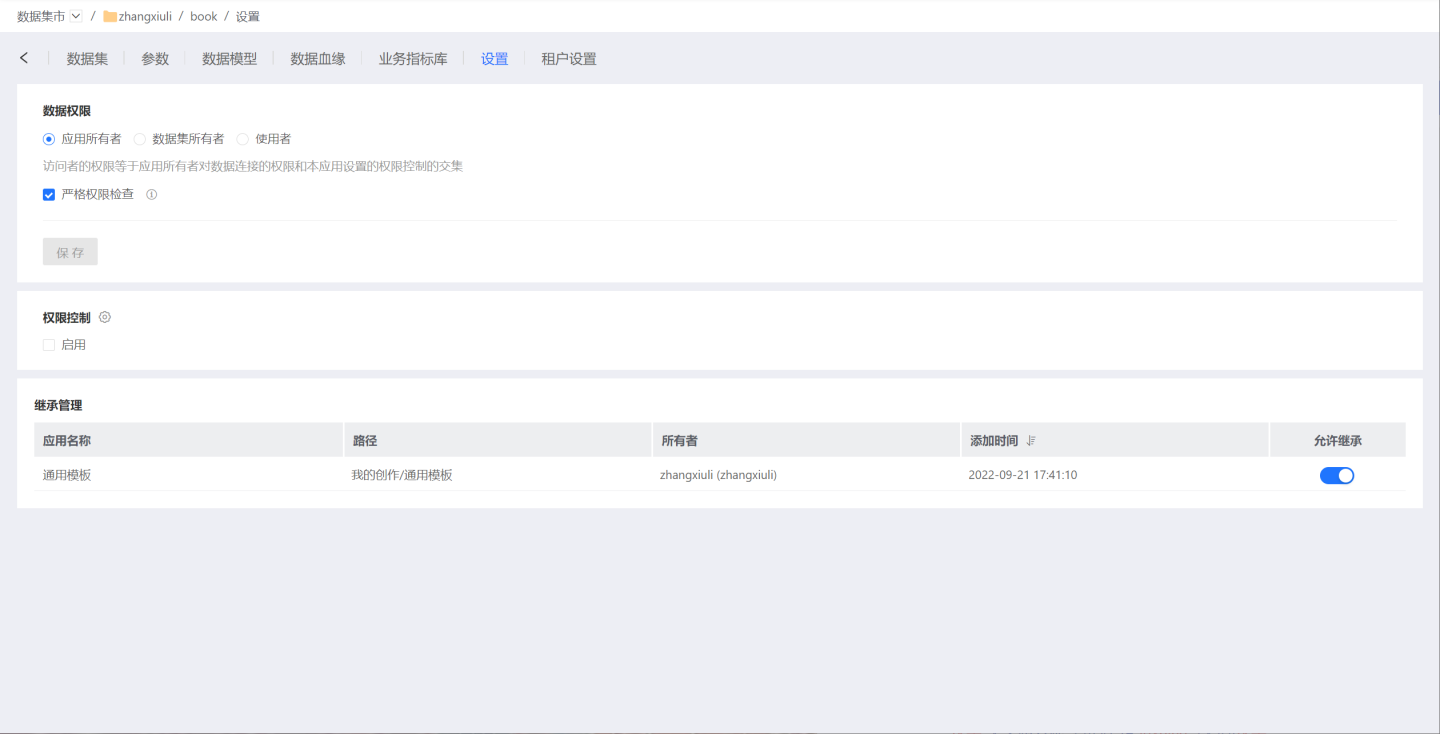
Data Permissions
Data permissions include: App Author, Dataset Author, and User, with the App Author option selected by default.
Mode Switching: During the process of switching dataset permission modes, datasets imported by the import engine need to be re-imported; switching from the App Author or Dataset Author mode to the User mode will cause union/imported datasets to become invalid.
For detailed information on data permissions, see Data Permissions.
Data Mode
Data often carries different security levels, making it accessible to different user groups. For example, highly secure data can only be shared and viewed by designated personnel, while less secure data, such as internally public data, can be displayed to all members. The system introduces strict and non-strict modes to accommodate data of different security levels.
- The strict permission mode is applicable to highly secure data, requiring all users to have permission for the data in order to view and use it.
- The non-strict permission mode is applicable to less secure data. Applications or data packages using these data can display them to users without data permissions for viewing and usage.
Permission Control
For detailed introduction to permission control, see Permission Control.
Inheritance Management
When an app needs to inherit data from a data package for data analysis, the app will send an inheritance request to the data package. The data package manager decides whether to allow the app to inherit. When the allow inheritance switch is turned on, the app will display the inherited dataset, which can be used for data analysis.

When a data package allows other apps to inherit, deleting the data package will prompt that there are apps currently inheriting. At this point, it can be forcibly deleted. After deletion, all inherited datasets in the apps that inherited the data package will disappear, and relevant charts using the inherited dataset will report errors.
Explore
New Exploration
In the Dataset Market, explorations can only be created within a data package. Click the New Exploration icon in the upper right corner of the data package to open the "Start Exploration" window. After selecting the chart type, you can begin your exploration. For chart-related operations, please refer to the Dashboard Controls user guide.

Save Chart
After creating a new exploration, you can choose to save the chart to a dashboard within your personal creations, team space, or application creation. The dashboard can be a newly created one or an existing one.
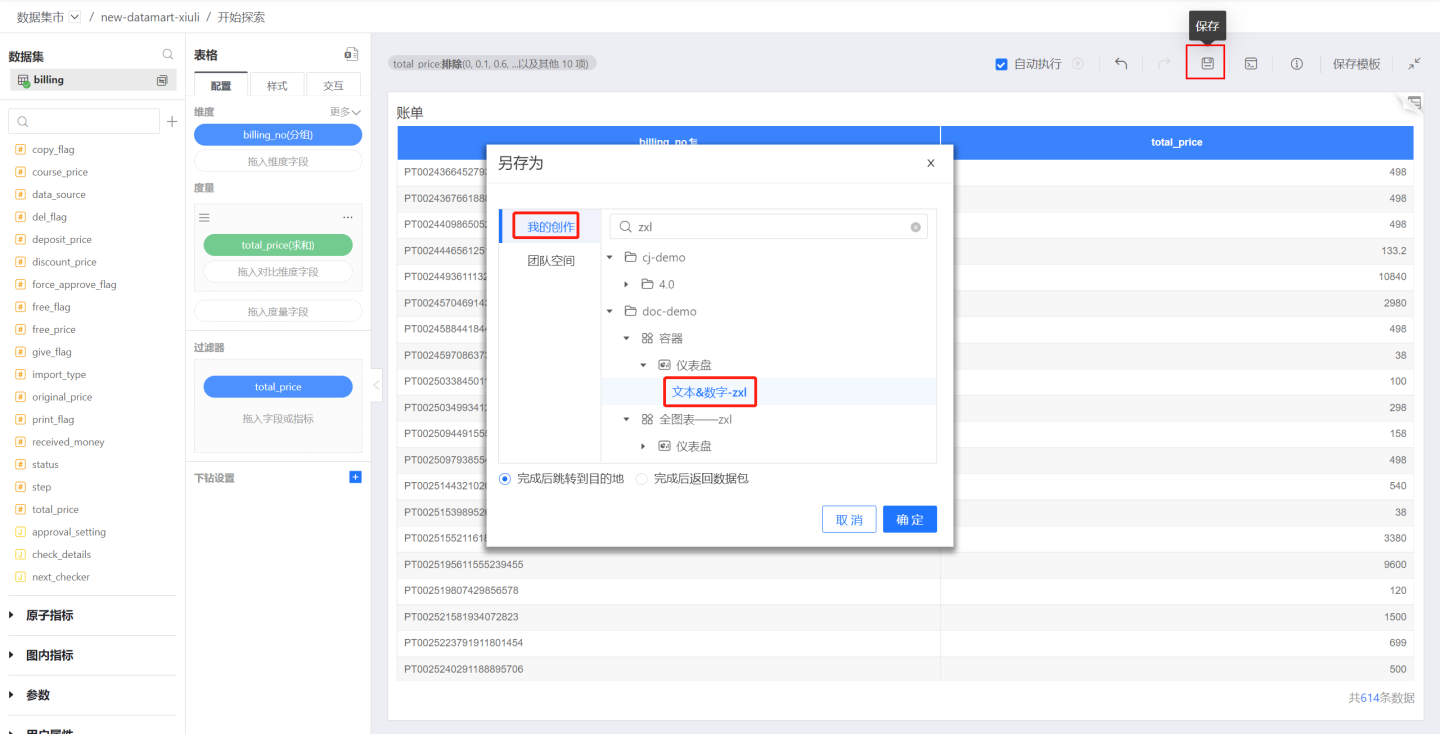
After successful saving, you can choose to jump to the chart page in "Application Creation -> Application -> Dashboard"; or you can choose to return to the data package page.
Delete Dataset
After creating a new exploration and deleting the dataset used for charting, when viewing the chart in App Creation, the prompt "The dataset does not exist in the application of the dataset market" will appear.